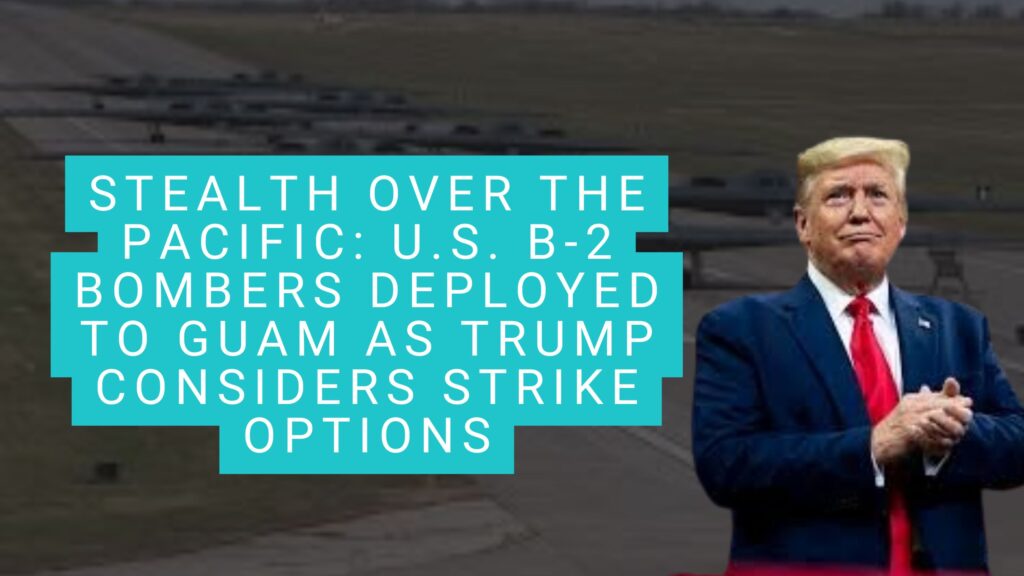Introduction: A Signal from the Skies
In a move that has reignited global headlines, the United States Air Force has deployed several B-2 Spirit stealth bombers to the Pacific island of Guam. Though military officials insist this is part of a routine rotational deployment, the timing is anything but ordinary. With President Donald Trump reportedly considering direct involvement in Israel’s escalating conflict with Iran, this deployment raises pressing questions about America’s next steps in a region already on edge.
Stealth Over the Pacific: U.S. B-2 Bombers Deployed to Guam as Trump Considers Strike Options
Guam, a tiny U.S. territory closer to Asia than the American mainland, is no stranger to being on the frontline of American military strategy. But the arrival of the B-2s—aircraft designed for one purpose: deep-penetration bombing—has stirred both unease and speculation.
Is this simply preparedness, or a precursor to something much more serious?

The B-2 Spirit: Silent, Deadly, and Strategic
To understand the gravity of this deployment, we need to understand the B-2 Spirit itself.
Nicknamed the “Spirit,” the B-2 is an aircraft that embodies stealth. It flies like a shadow, nearly invisible to radar. It can carry both conventional and nuclear weapons, but in the current geopolitical context, its most chilling feature may be its ability to deliver the Massive Ordnance Penetrator—a 30,000-pound bunker-busting bomb designed to destroy underground facilities like Iran’s heavily fortified nuclear sites.
It’s not just a plane; it’s a statement.
Deploying the B-2 isn’t about flying practice missions. It’s about sending a message: “We’re ready.”
U.S. Strikes on Iran’s Nuclear Facilities:
Fred Smith: The Visionary Who Revolutionized Global Delivery with FedEx
Why Guam? Why Now?
Guam serves as a strategic anchor point for U.S. power projection in the Asia-Pacific and beyond. From Guam, the B-2 can reach targets across Asia, the Middle East, and even Eastern Europe with aerial refueling.
The island is also far enough from potential threats to allow for relative security, yet close enough to act quickly in a crisis.
With Iran and Israel edging dangerously close to open warfare, the presence of B-2 bombers in Guam suddenly looks less like standard procedure and more like a chess piece placed near the center of the board.
Trump’s Calculus: Between Diplomacy and Force
Reports indicate that President Trump is actively reviewing military options in response to Iran’s alleged progress on nuclear weapons and Israel’s request for American support.
While no decision has been made, insiders suggest that the president has given the Pentagon a two-week window to present viable plans.
This isn’t unfamiliar territory for Trump. His foreign policy has long balanced brinkmanship with showmanship. But unlike the symbolic airstrikes of his first term, a direct U.S. role in striking Iran would be far more consequential—both politically and militarily.
Deploying the B-2s gives Trump leverage. It says: “We’re not bluffing.” But it also gives him options short of war—diplomatic pressure backed by real firepower.
Iran, Israel, and the Powder Keg
Israel has already launched targeted strikes against Iranian nuclear facilities, citing intelligence that Tehran has resumed uranium enrichment well beyond civilian use. Iran, for its part, denies these allegations but vows retaliation for any foreign aggression.
Caught in the middle are millions of civilians—families living under the constant threat of airstrikes, soldiers facing deployment, and diplomats trying to pull the brakes on a potentially catastrophic war.
The B-2s don’t drop bombs unless ordered—but their mere presence escalates the stakes for everyone involved.
Civilian Voices: Fears on the Ground
While political leaders deliberate in war rooms, people on the ground are living with uncertainty.
In Guam, the military presence is both a source of pride and anxiety. Residents have seen an uptick in surveillance aircraft and night flights. While locals are used to a strong U.S. military footprint, many say the mood feels different this time.
“It’s not the number of planes—it’s the tension in the air,” said one Guam resident. “People are watching the news a lot more closely.”
Meanwhile, Iranian and Israeli civilians are bracing for more air raid sirens. In Tehran, some are stocking up on food and water. In Tel Aviv, shelters are being inspected and fortified.
This isn’t just politics—it’s people’s lives.
Diego Garcia: A Step Closer to War?
Some military analysts suggest that if the U.S. were preparing for a real strike, the next move would be to relocate the B-2s to Diego Garcia—a remote Indian Ocean base even closer to the Middle East.
So far, that hasn’t happened. But rumors are swirling.
Diego Garcia was used in the past for strikes on Afghanistan and Iraq. If the bombers move there, it could signal imminent action.
For now, Guam remains the staging point—but that could change quickly.
What Happens Next?
Right now, the world is in a holding pattern. The B-2s are on alert. The President is reviewing classified briefings. Israel continues its limited strikes. And Iran remains defiant.
But war isn’t inevitable. Diplomacy is still on the table, and cooler heads may prevail. Still, the longer the bombers remain deployed, the more the world holds its breath.
Experts warn that even a “limited” strike could spiral. Iran could retaliate with cyberattacks, missile strikes, or proxy warfare through Hezbollah or other allies. Israel would respond. And the U.S. could be pulled in deeper than intended.
This is the razor’s edge of geopolitics.
Conclusion: Shadows, Strategy, and the Stakes
The B-2 deployment to Guam is more than just a military maneuver—it’s a geopolitical message written in jet exhaust and stealth wings.
Whether it remains a show of strength or becomes the start of something far more dangerous will depend on decisions made in Washington, Tehran, and Tel Aviv over the coming days.
For now, the world watches. The skies over Guam are quiet, but the silence is tense. And in that silence, history may be quietly unfolding.
🔍 FAQs: Understanding the Bigger Picture
Q: What is a B-2 Spirit bomber?
A stealth heavy bomber used by the U.S. Air Force, capable of flying undetected and delivering both conventional and nuclear weapons.
Q: Why is the U.S. deploying bombers to Guam?
While officially a routine deployment, the timing suggests strategic positioning amid growing tensions with Iran.
Q: Is the U.S. planning to strike Iran?
No decision has been made, but the possibility is under consideration by the President and the Pentagon.
Q: What is the Massive Ordnance Penetrator (MOP)?
A 30,000-pound bunker-busting bomb designed to destroy deeply buried facilities like those used in Iran’s nuclear program.
Q: How are civilians reacting?
With concern. In Guam, there is unease about escalation. In the Middle East, civilians fear another regional war.

